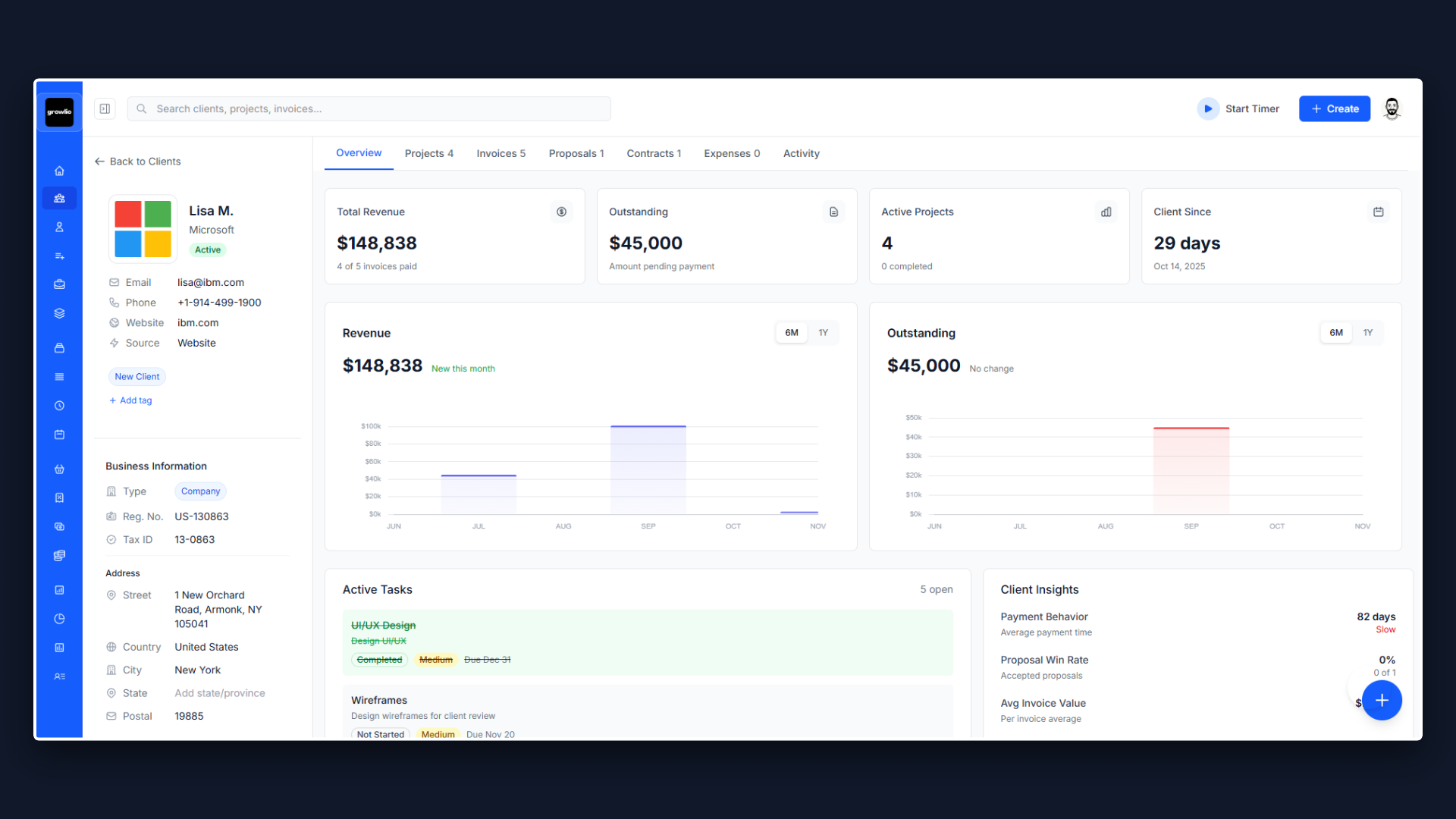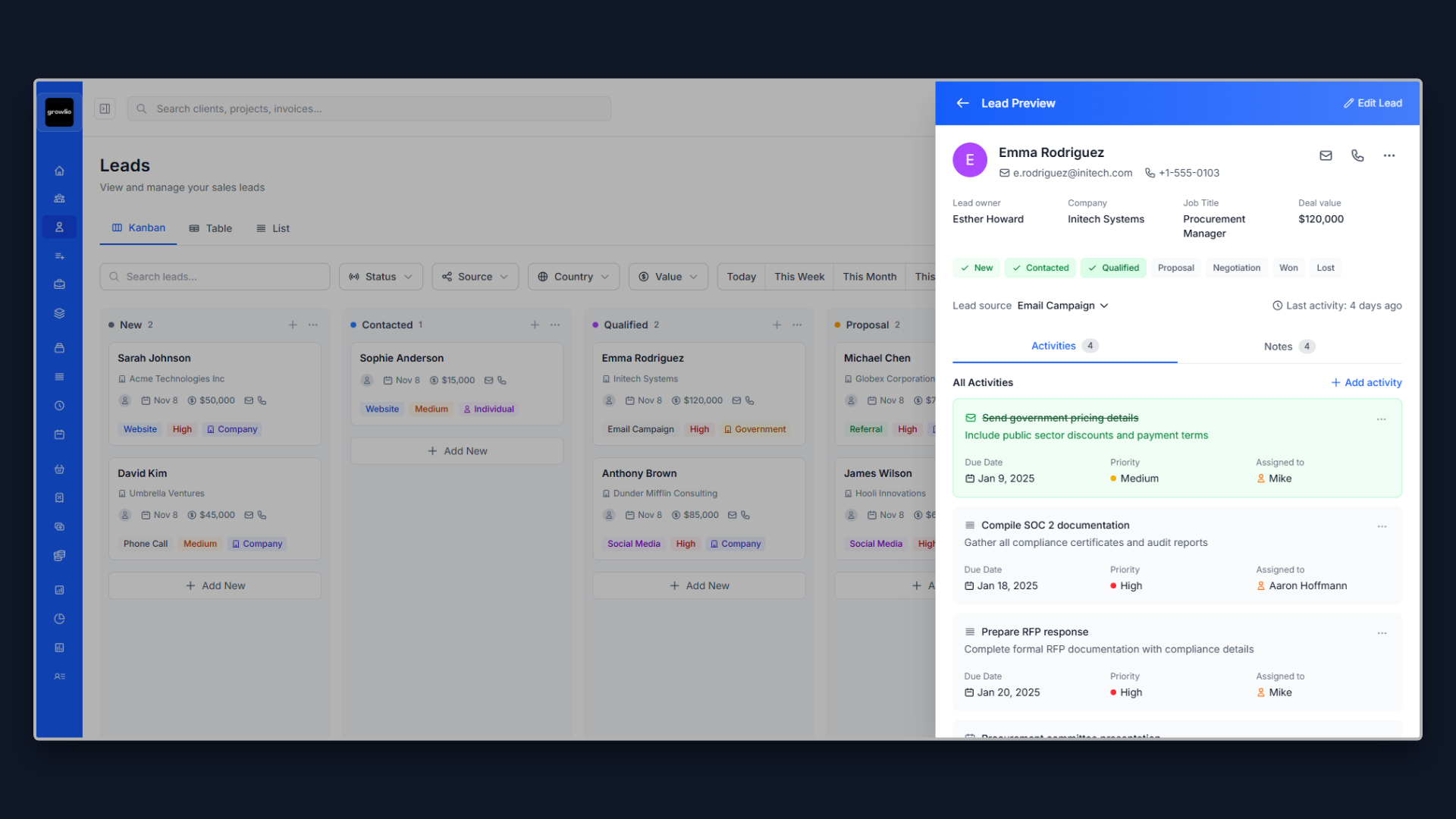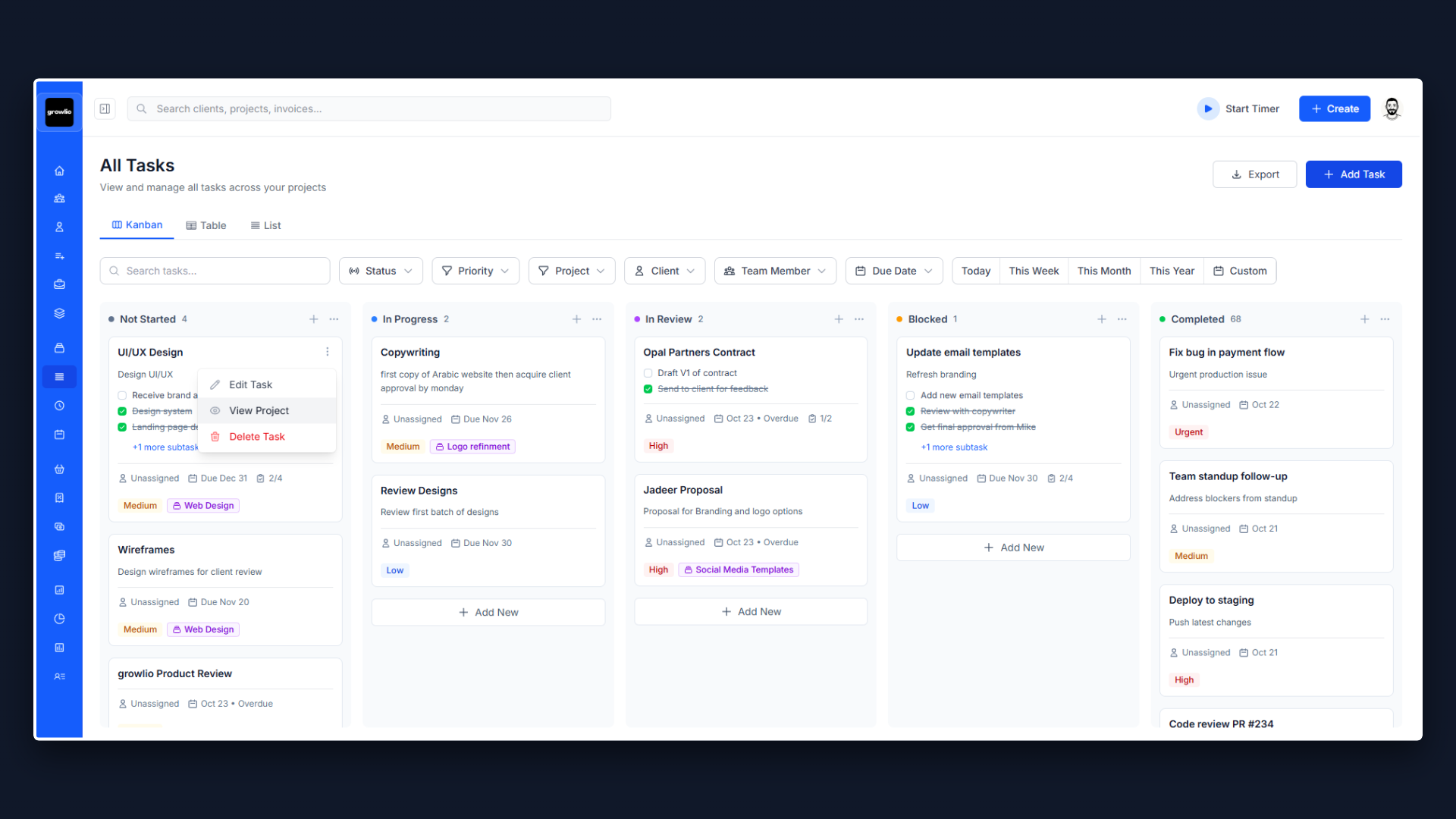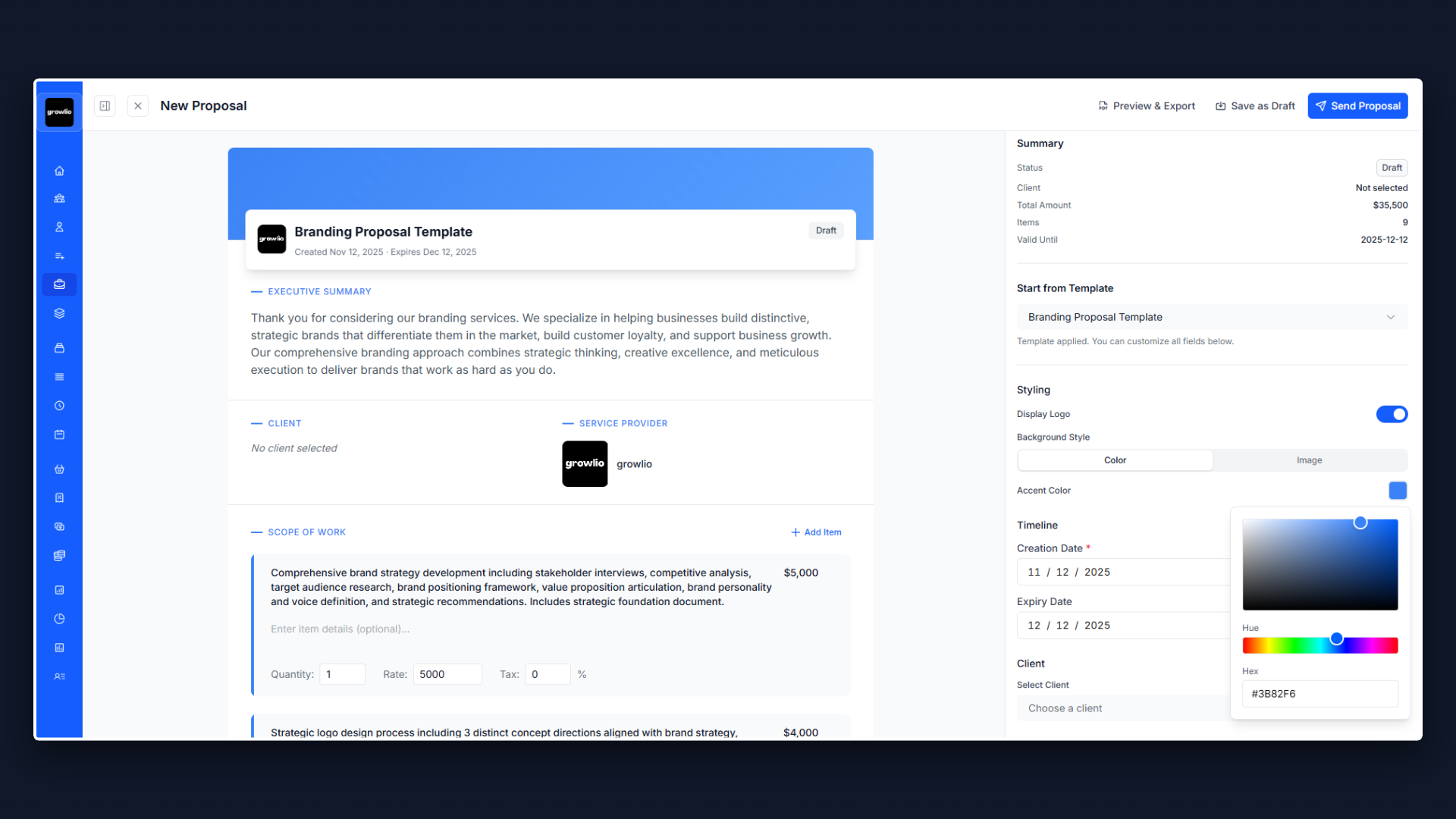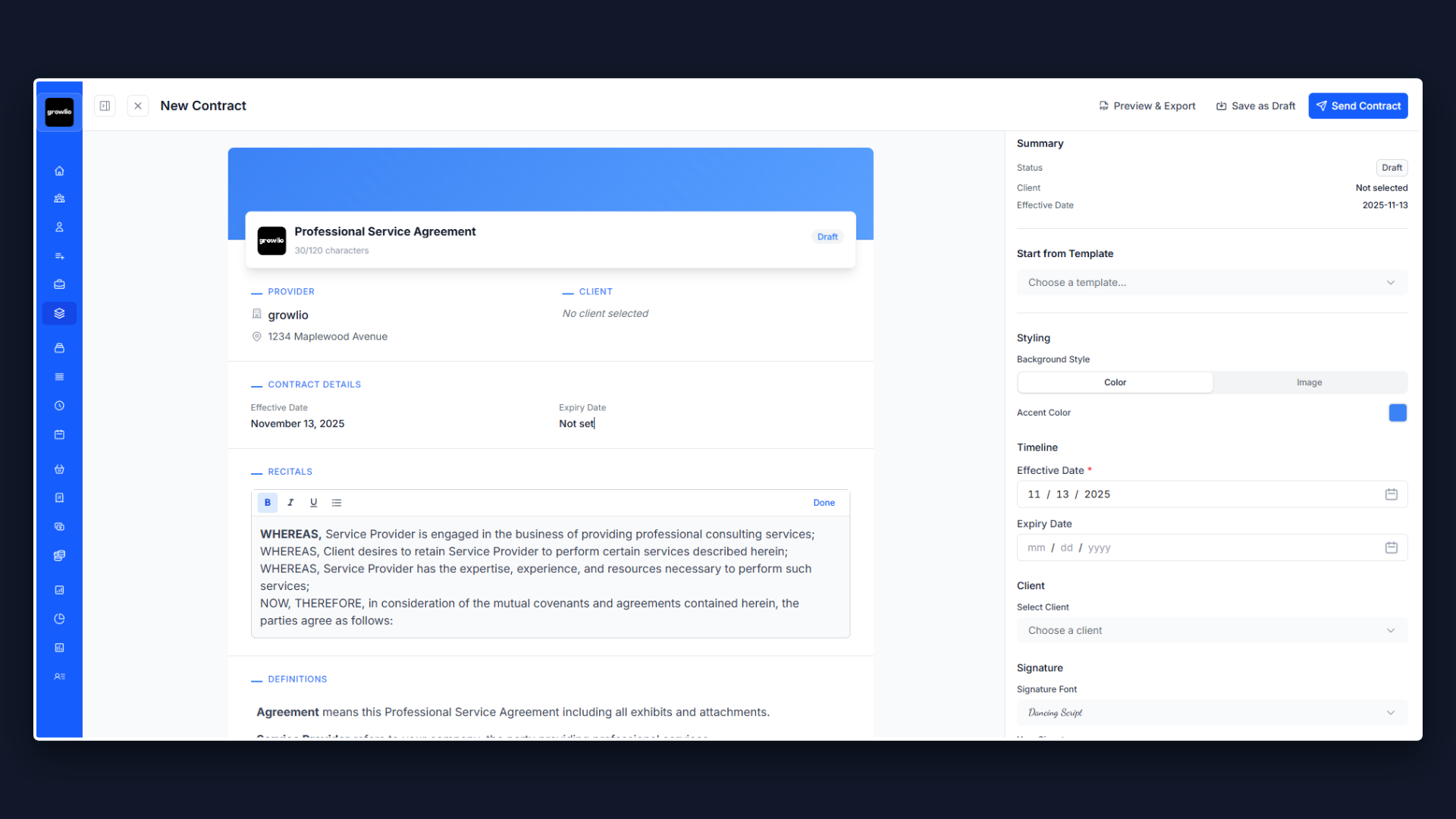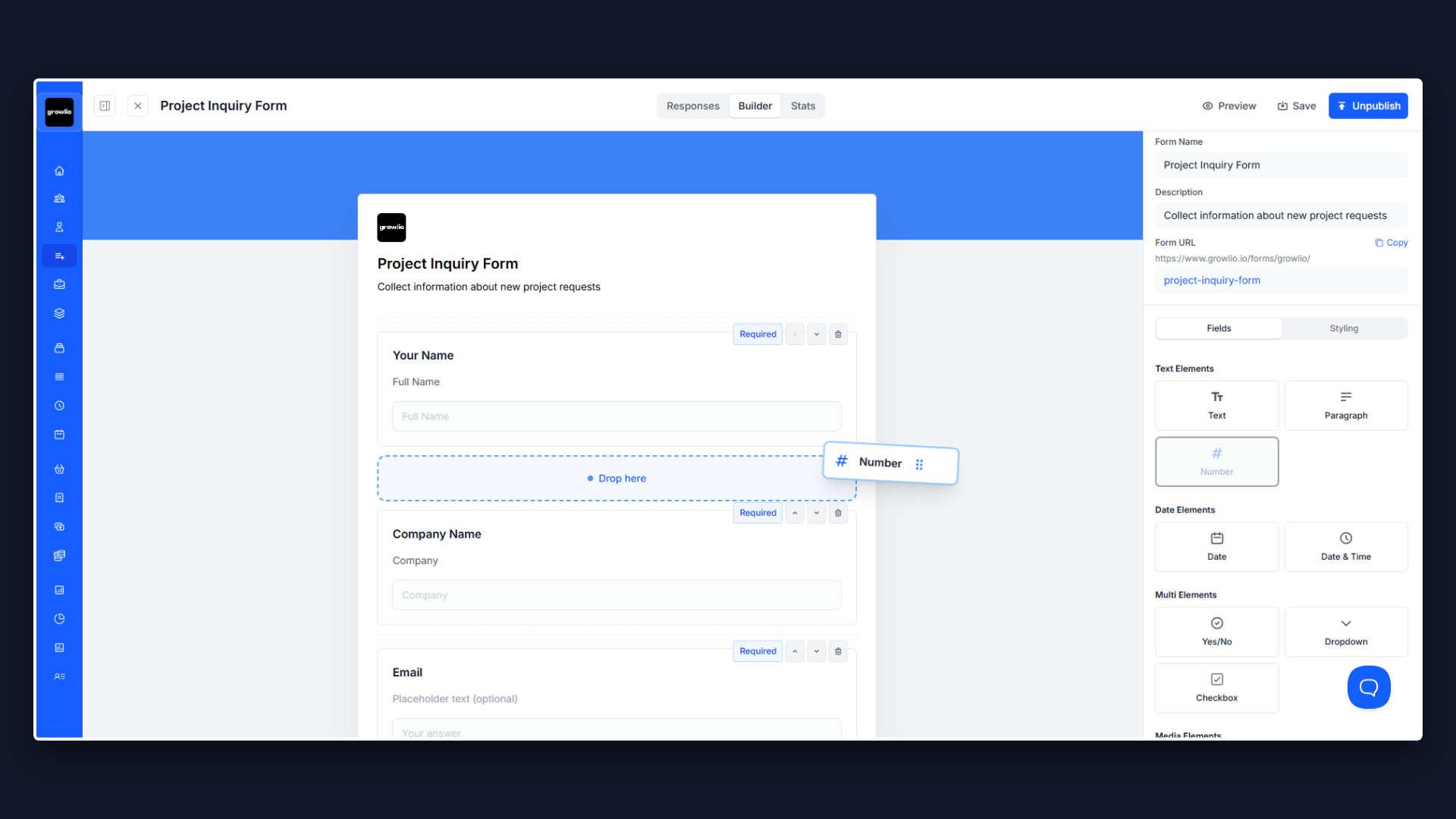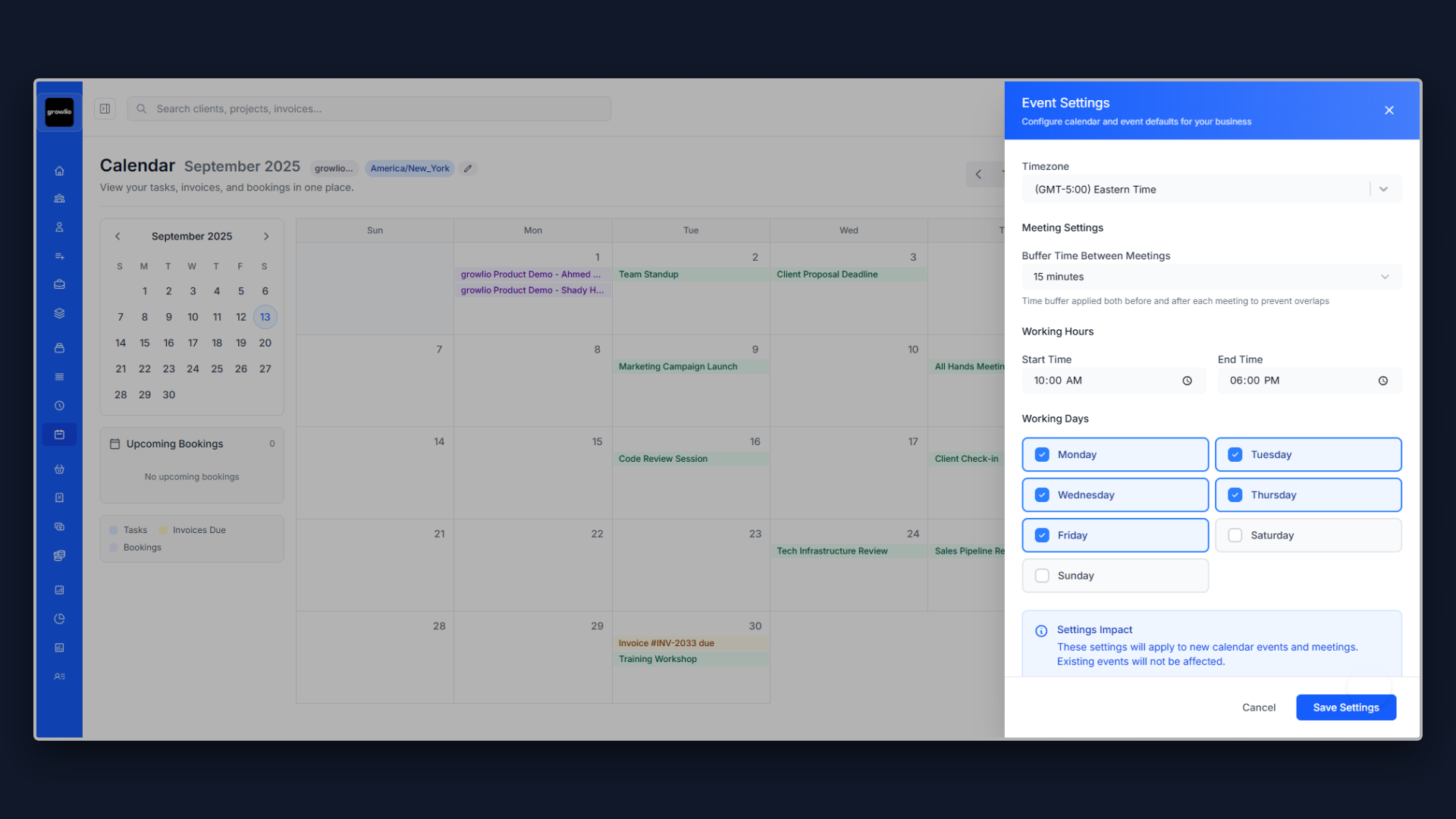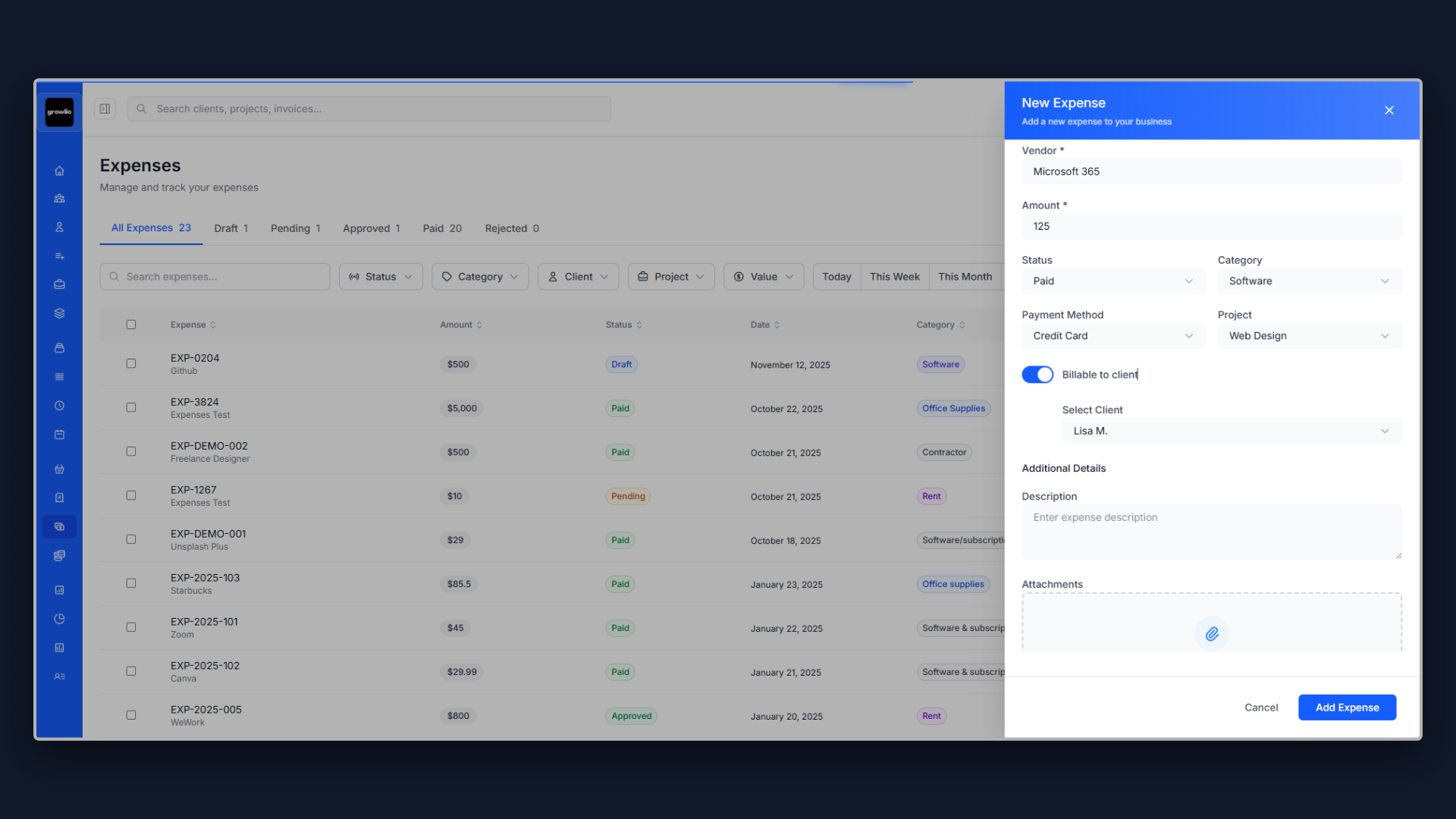Why Your Professional Services Proposal Makes or Breaks Client Relationships
In professional services, your proposal isn't just a price quote—it's the first demonstration of how you think, how you work, and how you'll serve your client. Before a business commits to engaging your expertise, they need confidence that you understand their needs, have a clear approach to solving their problems, and will deliver value that justifies your fees.
The professional services industry encompasses over $1.5 trillion globally, covering everything from legal services and accounting to consulting, design, marketing, and specialized technical expertise. Yet the difference between service providers charging $150/hour and those commanding $500+/hour often comes down to how they position their value in proposals.
Your professional services proposal needs to accomplish multiple objectives simultaneously: demonstrate deep understanding of the client's specific situation, prove you have expertise and methodology to deliver results, clearly define scope to prevent misunderstandings and scope creep, address concerns about cost, timeline, and ROI, and differentiate your approach from the dozens of other qualified providers they're considering. This is your opportunity to transform from a commodity service provider into a trusted strategic partner.
1. Lead With Client Outcomes, Not Your Service List
The biggest mistake professional service providers make is opening with a laundry list of services: "We provide strategy consulting, implementation support, training..." Your prospect doesn't care about your service menu yet. They care about their specific outcomes and goals.
Start by articulating the outcomes they're trying to achieve. For a business seeking marketing services, open with: "You need to generate 50 qualified leads per month to hit your revenue targets, but your current marketing efforts produce only 12-15 leads monthly at a cost per lead that's 3x industry benchmarks. You've tried content marketing, paid ads, and trade shows with inconsistent results. You need a systematic approach that delivers predictable lead flow, reduces acquisition costs, and scales with your growth plans. This isn't about more marketing activity—it's about building a revenue engine that consistently delivers results."
For a legal services prospect: "Your company is expanding into three new states, and you need to ensure compliance with varying employment laws, licensing requirements, and tax obligations. The cost of non-compliance could be six or seven figures in penalties and legal fees. You need an attorney who understands multi-state expansion, knows where companies typically make mistakes, and can guide you through the process efficiently without unnecessary legal bills. This is about protecting your business while enabling growth, not just reviewing documents."
This outcome-focused opening immediately shows you understand what success looks like for them, not just what services you sell. Now they're ready to hear your approach.
2. Define Scope With Exhaustive Clarity
Scope ambiguity creates endless conflict in professional services engagements. Clients expect more than you quoted for. You feel taken advantage of. Prevent this by defining scope exhaustively.
Structure scope definition precisely: Services Included in Engagement: Initial discovery and needs assessment (2-3 meetings). Detailed analysis of current state including documentation review and stakeholder interviews. Deliverable development (specific to service - strategy document, design files, legal briefs, etc.). Up to 2 rounds of revisions based on client feedback. Final presentation and knowledge transfer. Post-delivery support for 30 days (email and phone, up to 5 hours total). All work product and documentation delivered in agreed formats.
Explicitly Excluded from Scope: Implementation or execution of recommendations (available as separate engagement). Ongoing management or maintenance (available as retainer). Additional deliverables beyond those specified. Travel to client site (can be added at cost). Third-party costs (software licenses, stock photos, filing fees, etc.). Services from other departments or specializations. Rush delivery (under standard timeline).
Client Responsibilities: Provide requested information and documentation within 48 hours of request. Make decision-makers available for scheduled meetings. Provide feedback on drafts within agreed timeframes (typically 5 business days). Assign internal point of contact for coordination. Provide access to necessary systems, data, or locations. Make timely payment per agreed terms.
Assumptions: Project scope as outlined in this proposal. No significant changes to requirements mid-engagement. All necessary approvals and stakeholder buy-in obtained by client. Information provided by client is accurate and complete. Standard business days and hours (rush requests incur premium rates).
This level of detail prevents the "I thought that was included" conversations that damage client relationships and profitability.
3. Present Your Methodology to Build Confidence
Clients want to know you have a systematic approach, not just expertise. Your methodology section demonstrates you've solved this type of problem before and have a proven process.
Outline your approach in clear phases:
Phase 1: Discovery & Assessment (Week 1)
Kickoff meeting to align on objectives, timeline, and success criteria. Stakeholder interviews with key decision-makers and end users (typically 5-8 interviews). Document and data review (existing strategies, past work, competitive analysis, relevant data). Current state assessment identifying strengths, gaps, and opportunities. Discovery findings summary presenting key insights and recommendations for approach refinement.
Phase 2: Development & Creation (Weeks 2-4)
Detailed analysis applying our frameworks and methodologies. Solution development tailored to your specific situation and constraints. Draft deliverable creation with supporting documentation. Internal quality review ensuring deliverable meets our standards. First draft presentation with walkthrough and context.
Phase 3: Refinement & Finalization (Week 5)
Feedback collection and discussion to understand refinement needs. Revisions incorporating feedback (up to 2 rounds included). Validation with key stakeholders to ensure alignment. Final deliverable preparation in all agreed formats. Quality assurance review ensuring completeness and accuracy.
Phase 4: Delivery & Knowledge Transfer (Week 6)
Final presentation to stakeholders with implementation guidance. Documentation and supporting materials delivery. Knowledge transfer ensuring client can leverage deliverables independently. Implementation roadmap (if applicable) with next steps and milestones. 30-day support period for questions and clarifications.
This phased approach shows you have a systematic process while remaining flexible enough to adapt to their specific needs.
4. Showcase Credentials That Actually Matter
Generic credentials don't differentiate you. Focus on credentials, experience, and recognition that directly relate to solving their specific problem.
Present relevant credentials strategically: Relevant Experience: 15 years specializing in [their specific industry or problem type]. Worked with 50+ companies ranging from $10M to $500M in revenue. Typical client results: [specific, quantified outcomes relevant to their goals]. Deep expertise in [specific methodologies, regulations, or technical areas relevant to their needs].
Professional Credentials: [Relevant certifications - CPA, JD, MBA, industry-specific certifications]. Member of [relevant professional associations]. Published author/speaker on [relevant topics]. Guest lecturer at [relevant institutions or programs].
Recognition & Validation: [Industry awards or recognition]. Client testimonial: "[Specific quote about results delivered]" - [Name, Title, Company]. Featured in [relevant publications or media]. Average client satisfaction score: 4.8/5.0 over past 3 years.
What Makes Our Approach Different: [Specific proprietary methodology, framework, or tool]. [Unique background or perspective - former industry executive, specialized technical expertise, etc.]. [Commitment that differentiates you - guaranteed response time, specific quality standards, etc.]. [Resource advantage - specialized tools, proprietary data, strategic partnerships].
Focus on credentials that directly address their concerns: "Will this person understand my industry?" "Have they solved this problem before?" "What results have they delivered?" Generic credentials that don't answer these questions just add noise.
5. Present Pricing That Reflects Value, Not Just Time
Hourly billing commoditizes professional services and focuses clients on cost, not value. Present pricing structures that reflect the value you deliver.
Offer multiple pricing models: Option 1: Fixed-Fee Engagement - $45,000
All phases and deliverables as outlined in scope. Predictable investment with no hourly tracking or surprise invoices. Includes up to 2 revision rounds and 30-day post-delivery support. Payment terms: 30% at signing, 40% at draft delivery, 30% at final delivery. Best for: Clients who want budget certainty and comprehensive solution.
Option 2: Phased Engagement
Phase 1 (Discovery only): $8,000 - Understand your situation and recommend approach. Phase 2 (Development): $25,000 - Create deliverables based on discovery insights. Phase 3 (Implementation Support): $3,500/week - Help execute recommendations. Total if all phases: $45,000 + implementation support as needed. Best for: Clients who want to validate fit before full commitment.
Option 3: Retainer Model - $8,500/month
Ongoing access to our expertise for evolving needs. 25-30 hours of service per month (can flex across months). Priority scheduling and response times. Flexible scope adapting to highest-priority needs. Minimum 3-month commitment, then month-to-month. Best for: Clients needing continuous strategic support rather than one-time project.
Option 4: Success-Based Pricing - $25,000 + Performance Bonus
Base fee: $25,000 for all deliverables and standard engagement. Success bonus: Up to $30,000 based on achieving defined KPIs within 6 months. Example KPIs: 40+ qualified leads/month (from current 15), under $150 cost per lead (from current $400), 90%+ client satisfaction with deliverables. Total potential fee: $55,000 aligned with your results. Best for: Clients who want shared risk and reward.
Offering multiple pricing models gives clients choice while demonstrating confidence in your value delivery and flexibility in engagement structure.
6. Address the ROI Question Proactively
Clients always wonder: "Is this worth the investment?" Address ROI explicitly to justify your fees and position yourself as an investment, not an expense.
Quantify expected value: Investment: $45,000
Expected Returns (Conservative Estimates): Increased revenue: $180,000 annually from improved lead generation and conversion (based on industry benchmarks and your current metrics). Cost savings: $45,000 annually from operational efficiencies and reduced waste. Risk mitigation: Avoiding potential $75,000-$250,000 in compliance penalties or legal fees. Time savings: 15-20 hours per week for leadership team redirected from problem-solving to strategic work. Total quantifiable value: $225,000+ in Year 1.
ROI Calculation: First-year return: 5x investment. Break-even timeline: Approximately 2-3 months. Ongoing annual benefit: $225,000+ in subsequent years with no additional consulting investment.
Assumptions and Risks: Assumes you implement 80%+ of recommendations. Market conditions remain relatively stable. You allocate internal resources to support implementation. Results may vary based on execution quality and timing. Some benefits (strategic clarity, reduced stress, improved decision-making) are qualitative and not included in quantification above.
What If We're Wrong? Our typical client experiences 3-7x ROI in first year. If you don't see at least 2x return within 6 months, we'll work with you at no additional charge to troubleshoot and adjust approach. Our reputation depends on delivering value, not just completing projects.
This ROI framing transforms your proposal from "spending $45,000" to "investing $45,000 to generate $225,000+ in value"—a completely different decision framework.
7. Include Proof of Results Through Case Studies
Claims are easy. Proof is powerful. Include 2-3 brief case studies demonstrating you've delivered results for similar clients.
Format case studies concisely: Manufacturing Company - Operational Efficiency Engagement
Client: $75M industrial equipment manufacturer with declining margins
Challenge: Production costs 30% above industry benchmarks, quality issues causing customer complaints, unclear root causes of inefficiencies
Our Approach: 2-week operational assessment across 3 facilities, process mapping and waste identification, prioritized improvement roadmap, implementation support for quick wins
Results: 18% reduction in production costs within 6 months ($1.2M annual savings), 40% reduction in quality defects, 25% improvement in on-time delivery, project paid for itself in first 8 weeks
Client Quote: "They didn't just point out problems—they worked alongside our team to implement solutions that actually worked." - VP Operations
SaaS Company - Go-to-Market Strategy
Client: Series B SaaS company struggling to scale sales beyond founder-led efforts
Challenge: $8M revenue but stuck at plateau for 18 months, sales team missing quotas, unclear ideal customer profile and messaging
Our Approach: Customer interview program to identify buying patterns, ICP refinement and segmentation strategy, messaging framework and sales playbook development, sales team training and enablement
Results: Revenue grew from $8M to $15M over next 12 months, average deal size increased 35%, sales cycle shortened from 6 months to 3.5 months, sales team quota attainment improved from 45% to 78%
Client Quote: "They gave us the clarity and tools we needed to scale beyond founder-led sales. Best investment we've made." - CEO
Professional Services Firm - Brand Repositioning
Client: 50-person consulting firm competing on price and losing to larger competitors
Challenge: Seen as commodity provider, unable to command premium rates, difficulty attracting senior talent, founder considering selling or shutting down
Our Approach: Competitive differentiation analysis, brand strategy and positioning development, thought leadership program, website and marketing material redesign
Results: Average project fee increased 45% with higher close rate, attracted 3 senior hires from top firms, inbound lead volume tripled, firm acquired by larger competitor at 8x revenue (vs. 3-4x industry standard)
Client Quote: "They helped us see and articulate value we didn't know we had. Transformed our business." - Managing Partner
These specific, results-oriented examples prove you've delivered before and understand how to create measurable business impact.
8. Define Communication and Collaboration Expectations
Professional services engagements fail when communication breaks down. Set clear expectations about how you'll work together to prevent misunderstandings.
Outline your collaboration approach: Scheduled Touchpoints: Kickoff meeting (2 hours) - Week 1 to align on objectives, timeline, and working approach. Weekly status updates (30 minutes) during active phases to review progress and address questions. Mid-project check-in (1 hour) - Week 3 to present draft findings and gather feedback. Final presentation (1.5 hours) - Week 6 to deliver final recommendations and discuss implementation. 30-day post-delivery check-in to answer questions and ensure successful adoption.
Communication Channels: Email for routine questions, updates, and document sharing (response within 24 business hours). Phone/video calls for discussions requiring dialogue or explanation (scheduled or ad-hoc for urgent matters). Project portal for document sharing, version control, and progress tracking (access provided at kickoff). In-person meetings if needed (travel costs additional, billed at cost).
Your Project Team: Primary contact: [Name, Title] - day-to-day engagement management, deliverable creation, main point of contact. Senior advisor: [Name, Title] - strategic oversight, quality review, client escalation point, final presentations. Support team: [Roles] - research, analysis, design, or technical support as needed.
Your Responsibilities as Client: Provide timely feedback on deliverables (within 5 business days unless otherwise agreed). Make decision-makers available for scheduled meetings. Respond to information requests within 48 hours to maintain timeline. Escalate concerns or issues early so we can address them. Provide honest feedback so we can adjust approach if needed.
What Happens If We Miss a Deadline? If we miss agreed deadline due to our delays (not client feedback delays or scope changes), we'll provide 10% discount on final payment. We take deadlines seriously and build buffer into timelines to ensure on-time delivery.
This communication structure sets realistic expectations while demonstrating your commitment to transparency and accountability.
9. Address Common Objections Before They Arise
Every professional services buyer has concerns. Address the most common objections proactively in your proposal.
Tackle objections head-on: Objection: "Your fees seem high compared to other options."
Our response: We're typically not the cheapest option, and here's why: We focus on results and ROI, not just deliverables. Our typical client sees 3-7x return on investment in first year. Lower-cost providers often deliver generic recommendations requiring significant internal resources to customize and implement. Our approach is tailored to your specific situation and includes implementation guidance. We stand behind our work with post-delivery support and satisfaction commitment. Consider the cost of making the wrong decision versus the value of getting it right.
Objection: "How do I know you'll actually deliver results?"
Our response: Track record: We've delivered results for 50+ clients with average satisfaction rating of 4.8/5.0. Case studies in this proposal show specific, quantified outcomes. Reference calls: We'll provide contact information for 3 recent clients in similar situations. Phased approach: You can start with discovery phase only ($8,000) to validate our approach before full commitment. Performance guarantee: If you're not satisfied with deliverables, we'll revise at no charge or refund engagement fee (see terms in contract).
Objection: "What if our needs change mid-engagement?"
Our response: Flexibility is built into our process. Discovery phase often reveals needs different from initial assumptions—we adapt. Minor scope adjustments handled through open communication. Significant scope changes processed through change request with timeline and budget impact assessment. You're never locked into approach that doesn't make sense. We'd rather adjust than deliver work that doesn't meet your needs.
Objection: "We're not sure timing is right."
Our response: Consider the cost of waiting: Every month you delay, you continue experiencing current problems (lost revenue, inefficiencies, risks). Competitors who address these issues faster gain advantage. Some problems compound over time (technical debt, market share loss, talent attrition). That said, we'll hold proposed pricing for 60 days if you need time for budgeting or stakeholder alignment. We want you to engage when you're truly ready to act on recommendations.
Addressing objections proactively shows confidence and removes barriers to decision-making.
10. End With Clear Decision Framework and Next Steps
Make the decision easy by clarifying what they should consider and providing frictionless next steps.
"We appreciate the opportunity to submit this proposal and hope to partner with you on this important initiative. As you evaluate service providers, we recommend considering:
Relevant Expertise: Do they have specific experience with your type of challenge? Can they provide examples of similar results? Do they understand your industry context?
Approach and Methodology: Is their process clear and systematic? Do they customize to your situation or use one-size-fits-all solutions? How do they ensure quality?
Value and ROI: What results can you expect? What's the expected return on investment? How do they measure success?
Working Relationship: Do you trust them? Are they collaborative or dictatorial? Will they be responsive and available? Do communication styles align?
Commercial Terms: Is pricing structure clear and fair? Are there options for different risk tolerances? What happens if you're unsatisfied?
Ready to Move Forward?
Step 1: Schedule a 30-minute call to discuss any questions and ensure this engagement is the right fit for both of us. [Calendar link] or reply to this email.
Step 2: Upon mutual agreement to proceed, we'll send a formal engagement agreement outlining all terms, deliverables, and responsibilities.
Step 3: We can typically begin within 5-7 business days of signed agreement. We'll schedule kickoff meeting and send initial discovery materials.
Not Ready Yet? No problem. We're happy to stay in touch and answer questions as you work through your decision process. We'd rather you engage when the timing is right than feel pressured into premature commitment.
Questions? Contact [Name] at [email] or [phone]. We're here to help you think through this decision, even if you ultimately choose a different provider."
This consultative closing positions you as a trusted advisor, not a desperate vendor, while making next steps completely clear.
Final Thoughts on Professional Services Proposals
Your professional services proposal is more than a price quote—it's the first demonstration of how you'll serve your client. It proves you can listen, think strategically, communicate clearly, and deliver value. A weak, generic proposal suggests weak, generic service delivery. A thoughtful, customized proposal suggests the same quality of work.
The service providers who win premium engagements and build sustainable businesses focus on client outcomes, not service lists, define scope exhaustively to prevent misunderstandings, present systematic methodology that builds confidence, price based on value delivered, not just time spent, provide proof of results through specific case studies, address ROI explicitly to justify investment, set clear communication expectations, tackle objections proactively, and make the decision easy with clear next steps.
Every proposal should be deeply customized for the specific client and situation. Reference their specific challenges with insights from your initial conversations. Include preliminary thinking or observations showing you've already begun analyzing their situation. Share relevant case studies demonstrating you've solved similar problems. Be transparent about scope, pricing, and assumptions. And always position yourself as a trusted partner invested in their success, not just a vendor completing transactions.
Remember: a great professional services proposal proves you understand their specific situation and desired outcomes, demonstrates expertise and methodology that delivers results, reduces perceived risk through proof and guarantees, quantifies expected ROI making the investment decision easier, and differentiates you from competitors through unique value proposition. Get these elements right, and you'll win more engagements at premium prices—building a thriving professional services practice where clients seek you out rather than you chasing them.
